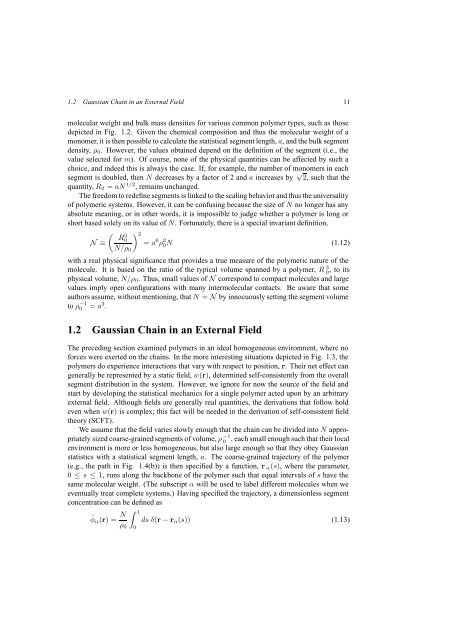Self-Consistent Field Theory and Its Applications by M. W. Matsen
Self-Consistent Field Theory and Its Applications by M. W. Matsen
Self-Consistent Field Theory and Its Applications by M. W. Matsen
Create successful ePaper yourself
Turn your PDF publications into a flip-book with our unique Google optimized e-Paper software.
1.2 Gaussian Chain in an External <strong>Field</strong> 11<br />
molecular weight <strong>and</strong> bulk mass densities for various common polymer types, such as those<br />
depicted in Fig. 1.2. Given the chemical composition <strong>and</strong> thus the molecular weight of a<br />
monomer, it is then possible to calculate the statistical segment length, a, <strong>and</strong> the bulk segment<br />
density, ρ 0 . However, the values obtained depend on the definition of the segment (i.e., the<br />
value selected for m). Of course, none of the physical quantities can be affected <strong>by</strong> such a<br />
choice, <strong>and</strong> indeed this is always the case. If, for example, the number of monomers in each<br />
segment is doubled, then N decreases <strong>by</strong> a factor of 2 <strong>and</strong> a increases <strong>by</strong> √ 2, such that the<br />
quantity, R 0 = aN 1/2 , remains unchanged.<br />
The freedom to redefine segments is linked to the scaling behavior <strong>and</strong> thus the universality<br />
of polymeric systems. However, it can be confusing because the size of N no longer has any<br />
absolute meaning, or in other words, it is impossible to judge whether a polymer is long or<br />
short based solely on its value of N. Fortunately, there is a special invariant definition,<br />
( ) R<br />
3 2<br />
N≡ 0<br />
= a 6 ρ 2 0<br />
N/ρ N (1.12)<br />
0<br />
with a real physical significance that provides a true measure of the polymeric nature of the<br />
molecule. It is based on the ratio of the typical volume spanned <strong>by</strong> a polymer, R 0 3 , to its<br />
physical volume, N/ρ 0 . Thus, small values of N correspond to compact molecules <strong>and</strong> large<br />
values imply open configurations with many intermolecular contacts. Be aware that some<br />
authors assume, without mentioning, that N = N <strong>by</strong> innocuously setting the segment volume<br />
to ρ −1<br />
0 = a 3 .<br />
1.2 Gaussian Chain in an External <strong>Field</strong><br />
, each small enough such that their local<br />
environment is more or less homogeneous, but also large enough so that they obey Gaussian<br />
statistics with a statistical segment length, a. The coarse-grained trajectory of the polymer<br />
(e.g., the path in Fig. 1.4(b)) is then specified <strong>by</strong> a function, r α (s), where the parameter,<br />
0 ≤ s ≤ 1, runs along the backbone of the polymer such that equal intervals of s have the<br />
same molecular weight. (The subscript α will be used to label different molecules when we<br />
eventually treat complete systems.) Having specified the trajectory, a dimensionless segment<br />
concentration can be defined as<br />
The preceding section examined polymers in an ideal homogeneous environment, where no<br />
forces were exerted on the chains. In the more interesting situations depicted in Fig. 1.3, the<br />
polymers do experience interactions that vary with respect to position, r. Their net effect can<br />
generally be represented <strong>by</strong> a static field, w(r), determined self-consistently from the overall<br />
segment distribution in the system. However, we ignore for now the source of the field <strong>and</strong><br />
start <strong>by</strong> developing the statistical mechanics for a single polymer acted upon <strong>by</strong> an arbitrary<br />
external field. Although fields are generally real quantities, the derivations that follow hold<br />
even when w(r) is complex; this fact will be needed in the derivation of self-consistent field<br />
theory (SCFT).<br />
We assume that the field varies slowly enough that the chain can be divided into N appropriately<br />
sized coarse-grained segments of volume, ρ −1<br />
0<br />
ˆφ α (r) = N ∫ 1<br />
ds δ(r − r α (s)) (1.13)<br />
ρ 0<br />
0
















